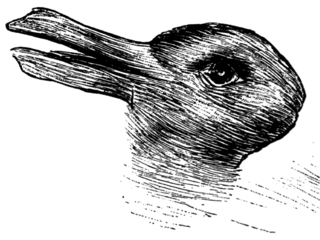President Donald Trump
The Trump-Goldfinger Illusion
Perceptual similarity as political weapon.
Posted September 29, 2017
Remember the duck-rabbit illusion?

It can be seen both as a duck and as a rabbit. If you first see it as a duck and later notice that it can also be seen as a rabbit, your experience changes significantly. And it is impossible to go back to your naïve pre-rabbit experience. The rabbit aspect will always color your experience of the figure.
Here is a similar illusion, which is much more timely. Goldfinger, as you may recall, was one of the early James Bond films. This is the one where the gold-obsessed villain, Auric Goldfinger, schemes to blow up the entire federal gold reserve in Fort Knox.
It’s an old film, but if you’ve seen it recently, say, in the last couple of years, it’s impossible not to notice the uncanny resemblance between the look of the villain Goldfinger and, well, the current president of the U.S.

Once you’ve seen this similarity, it’s very difficult to unsee it. And it really messes with your mind when you watch the movie, especially given that Goldfinger blows up the federal gold reserve in order to increase the value of his own gold holdings. For me, at least, this now takes a lot away from the enjoyment of the film.
There is more at stake here than a cheap visual joke. This phenomenon can help us understand just how complex and emotionally charged perception can be. We know a lot about the psychological mechanism of how this happens. The perceptual processing of what you see is influenced at a very early stage of your past experiences in a top-down manner.
What you know and what you expect has a real impact on your perceptual experience. And these top-down influences are often emotional affairs and already influence the earliest stages of perceptual processing. For example, if you are primed with scary music, you are much more likely to see a scary crocodile in an ambiguous stimulus than a cute squirrel. Given how emotionally charged politics is these days, we should not be surprised that affective priming spills over into the domain of politics.
The Trump-Goldfinger illusion is a bit like the famous duck-rabbit illusion, but there is a huge difference. Seeing the duck-rabbit does not influence how you see everyday ducks (or rabbits) in the future. But once you saw the Trump-Goldfinger illusion, it is very difficult to look at the picture of Goldfinger in a way that you don’t see Trump and vice versa. The duck-rabbit does not do any affective priming, but the Trump-Goldfinger illusion does.
Trump coloring your Goldfinger experience is not so great: you will probably enjoy this movie a little less next time. But the converse effect is even more important. Once you saw the Trump-Goldfinger illusion, each time you see Trump, on a very low, perceptual and presumably unconscious level Goldfinger will influence your experience of Trump.
That's where the Trump-Goldfinger illusion becomes more than a cheap political point. It may be a more efficient way of planting mistrust in the mind of a Trump supporter than giving clear and rational arguments about his policy decisions. Visual similarity is a powerful political weapon and it should be handled with care.
George Lakoff has argued for a long time that political decisions are not made on a rational level. He emphasized the contribution of political metaphors and the political language in general in shaping our political views. My point is that it all starts at an even earlier, even more rudimentary level. It starts with perception. There is no part of our life that is entirely politics free—not even watching an old James Bond movie.


